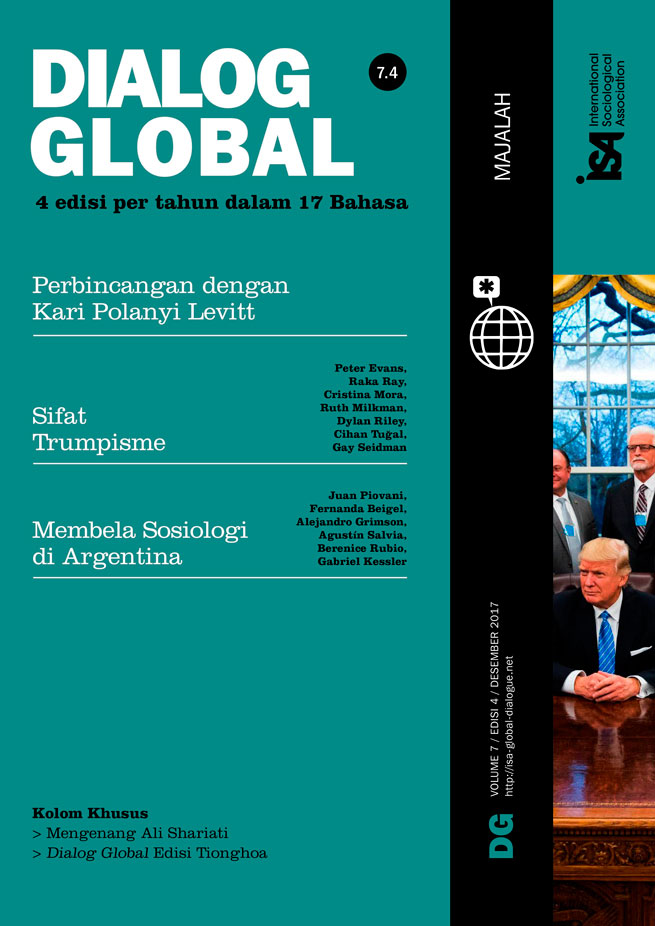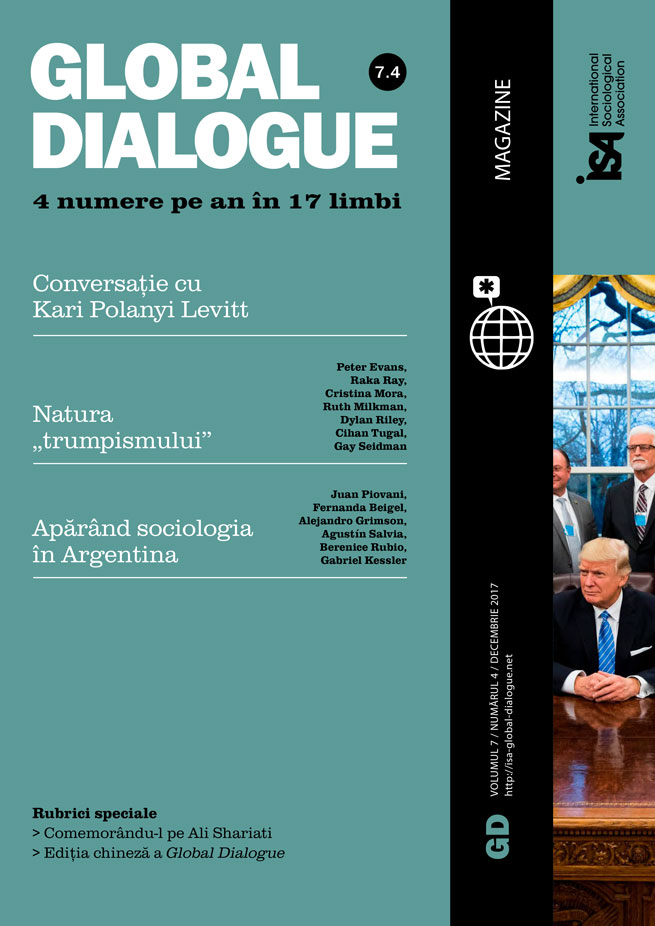The victory of right-wing populism in America took half of the nation by surprise. If contextualized in a world-historical manner, however, it is far from shocking. In a nutshell, the boom-and-bust cycles of the neoliberal era have exhausted themselves. Economic crisis does not directly translate into a broader political problem, but the (post-1970s) ideological attack against all forms of collectivism have deprived humanity of centrist and left-tinged ways of fixing capitalism. Neoliberal devolution and persistent anti-collectivism are global trends, and I will say less about them here. In America, these have been aggravated, over the past several decades, by a historical migration of populist language and politics from the left to the right. As a result, the left cannot even mount a proper populist challenge (let alone save capitalism or overthrow it), while the right-wing challenge is full of energy, spirit, and promises – if not real solutions.
The liberalization of the left
The left can no longer convincingly speak in a populist tone. It doesn’t know how. In any case, most of its ideologues don’t want to. In order to understand the meagerness of populist overtones within the American left, we need to look at the pre-history of our era’s anti-populism.
I trace this devolution, paradoxically, to what seemed on paper to be the most democratic revolt of the 20th century: 1968 (as it was experienced in the West). Alongside its anti-capitalism, 1968 was a revolt against the statist and bureaucratic excesses of Stalinism, social democracy, and the New Deal. Although justified in many regards, the anti-bureaucratic mood of that moment ultimately led many to draw wrong lessons from the downfall of statism and the victory of (neo)liberalism. 1968 was a necessary mistake. The right recovered from it. The left did not.
The two major inheritors of 1968 in the West – the liberal-left and autonomist/anarchist movements – developed an incurable suspicion not only of organization, ideology, and leadership, but also of speaking in the name of majorities, “the people.” All such talk (and politics) came to be branded “totalizing” and totalitarian (by the far left) or “irresponsible” and useless (by the liberal left). Except in Southern Europe (where left populism returned to the scene, but without class, ideological, and organizational anchors) and Latin America, the right occupied the emergent gap.
Defeated on paper, the libertarian spirit of 1968 fueled neoliberalism’s anti-statism. But the more poisonous result was the subsequent split of leftists, between post-modernist nihilism and left-liberalism.
What was left-liberalism’s project? Although global in its causes and manifestations, left-liberalism found its purest expressions in the United States and Britain. The catchword was inclusion, which came to replace equality. Inspired by sociologists such as Anthony Giddens, the new Anglophone center (New Labor and Clintonism) focused on including more people at the table. Over three decades, inclusion increased in terms of race, gender, and sexual orientation — but the table itself shrank. So yes, Black and Latino men and women, even Muslims, got prominent positions at institutions they could previously hardly dream of; but the Black and Latino prison population in the US increased, as did the number of Muslims bombed, embargoed and starved by the United States.
Left-liberalism spoke to (more ordinary) minorities through targeted welfare programs; but since Democratic leaders shied away from taking from the big sharks, it could only do this by further victimizing the whites pushed away from a shrinking table. Downgraded whites came to be perceived as a bunch of racists, “a basket of deplorables”; people we can no longer talk to (a reality produced by the project itself).
The left’s self-destruction and service to the right
As a result, minorities are not mobilized and organized in sustained fashion (producing the famous “missing” black vote of the 2016 US elections); downgraded whites distrust both parties, but find liberals more abhorrent. Up until the rise of Sanders, the establishment left (both the liberal left and the progressives) was caught in this liberal game of elite-driven “diversity” and “inclusion.” These entrenched political dispositions render a New Deal scenario highly unlikely.
What of the far left? Despite a strong dislike of the liberal left, many radical intellectuals and activists share its celebration of the “end of ideology” and organized leadership (resulting in “rhizomes” on the left, and electoralism among progressive Democrats). From Seattle to Occupy, the American left did its best not only to avoid, but to undermine organized leadership. As the center collapsed, therefore, the right was far more equipped to respond. First and foremost, rightists gave up neither ideology nor organized leadership. On paper, they fought against both, but only while manufacturing ideologies, organizations, and leaders under the radar.
While the left buried whatever remained of the ideologies and organizations of 1968 (even while celebrating 1968 for its libertarian and counter-culture spirit), the American right organized as a revolt against 1968. But unlike the residues of the revolution it claimed to be fighting, the right was organized and ideological. Its success in shifting the mainstream to the far right actually built on the repressed strategies and tactics of one forgotten wing of 1968: a particular reading of Lenin’s theory of revolution.
The American Right’s “21st-century Leninism”
The dismissal of Steve Bannon – leading intellectual of the US alt-right – before the first anniversary of Trump’s presidency comes as false relief. In fact, Bannon’s White House adventure was only one stage of a long journey – the migration of revolutionary-populist language, tactics, and strategies from the left to the right. Bannon has reportedly said: “I’m a Leninist. Lenin […] wanted to destroy the state, and that’s my goal too. I want to bring everything crashing down, and destroy all of today’s establishment.” But what does this Leninism consist of? In a complex democracy, Leninism can only maintain itself as a populism of the long revolution. For decades, social science has insisted that due to entrenched institutions, no third party can succeed in the US. This very “scientific fact” has enabled a smug self-certainty among liberal leftists and autonomists/anarchists (who find therein further justification for, respectively, their subservience to neoliberalism and evasion of organized politics). The American far right has subverted this “fact.” It was as if they were following directions from a 21st-century, condensed version of Lenin’s (1902) What is to Be Done?, starting with the sentence: “If you can’t build a party, paralyze the party; circumvent it; and take it over.” They did all three simultaneously. Our imaginary, revised What is to Be Done? would then continue: “Before you become the de jure leaders of the party, make sure all of its institutions are crippled.” If the Tea Party (a populist grouping among Republicans) had not already paralyzed the Republican establishment, the latter would have been able to stop Trump’s rise.
American right-wing populism is Leninism under democratic conditions. Unlike the Russian Bolsheviks who had to avoid almost all above-ground society and politics, American rightists embrace society. The revised What is to Be Done? would therefore say: “Organize in every cell of society. Don’t underestimate any venue of organization and politics, even if (especially if) it seems to belong to the enemy camp.” The right learned not to leave education, science, and culture to the monopoly of the left. “Appropriate the organizational terrain and ideology of your enemy, to the extent possible. Dismantle whatever you fail to appropriate.” Starting with Andrew Breitbart himself, the founder of the “alt-right” media outlet, the right read the Frankfurt School; it made healthcare a big deal; and with the rise of Trump and Bannon, it promises jobs and infrastructure.
Today the Leninist Right cannot ignore the existence of other potentially populist forces on the social map, however meager they may be. The 21st-century What is to Be Done? would thus conclude with the sentence: “If certain trenches of the enemy appear to be beyond the reach of any of these tactics, provoke its occupants into immature and illegitimate action.” As the alt-right descended on the University of California, Berkeley and other pockets of residual left-wing influence in early 2017, liberals came to their defense (in the name of “free speech”) when a far left without a mass base attacked them. Liberal enthusiasm for “free speech” diminished slightly after an alt-rightist drove a truck into an anti-racist crowd in Charlottesville, but the Washington Post still emphasized far left violence and the alt-right’s freedoms when the latter returned to Berkeley in September 2017. Many birds are killed with one stone: the enemy is divided; its confusion, lack of will, and weakness are exposed; its reputation is tarnished; and the far right itself is further galvanized.
Since “the state” today is more complex than any 20th-century definition could capture, “smashing” it involves much less dramatic action than in 1917, at least for now. We still don’t know what the right holds in store for the time when the existing institutions are completely incapacitated, but we may soon find out. Right after his resignation, Steve Bannon declared “war” on his enemies, adding gleefully that he is returning to his “weapons” (meaning electronic media). A populist revolution in a land of entrenched (if decaying) liberalism is an uphill battle, and is bound to suffer setbacks. But the show is far from over.
Cihan Tuğal, University of California, Berkeley, USA <ctugal@berkeley.edu>
























